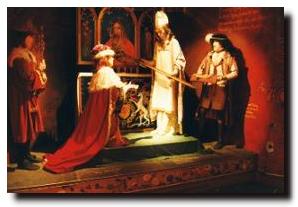
King James III had a turbulent reign and in 1482, an English army, supporting the cause of James' brother, Alexander, Duke of Albany, invaded Scotland. A group of Scottish nobles imprisoned the King in Edinburgh castle as the English army advanced towards the capital. James survived but following further conflicts with some of the Border families, these rebels encouraged his 15-year-old son to claim the throne. The opposing armies, both flying the lion rampant, met at the Battle of Sauchieburn, near Bannockburn on 11 June 1488. King James III was wounded in the battle and subsequently killed by a man pretending to be a priest.
James IV was crowned at Scone on 26 June 1488. As penance for causing the death of his father, James wore an iron chain for the rest of his life. James IV made strenuous efforts, with the aid of the Campbells and the Gordons to extend sovereignty over the Lord of the Isles and eventually succeeded. He is also credited with creating an impressive navy (including the ship "The Great Michael") and a Renaissance court. He was a patron of poets such as William Dunbar and built or extended palaces at Holyrood, Falkland and Linlithgow.
James had at least three illegitimate children and is known to have written poems to a female companion, Margaret Drummond. There were rumours that he had married her in secret. But, perhaps conveniently, she died of poisoning in 1501 and James married Margaret Tudor, daughter of Henry VII in 1503. (It was as a consequence of this marriage that the Union of the Crowns was to take place exactly 100 years later). The match had been planned for some time but had to wait until she reached marriageable age (14 in those days).
James IV was a man of many skills - he was known to practise dentistry and even charged his patients for his services. He also founded the Royal College of Surgeons in 1505 which was 35 years earlier than the equivalent in England. He introduced compulsory education for the first time, requiring his large landowners to send their sons to school and to one of the universities then in existence at St Andrews, Glasgow and Aberdeen.
The peace between Scotland and England which arose from the marriage lasted ten years. But James had renewed the "Auld Alliance" with France - and King Henry VIII of England had invaded the France of King Louis XII. Because of treaties which had been signed between Scotland and England in 1502, James did not need to take action . But, perhaps out of chivalry, perhaps out of a hope of winning territory while King Henry VIII was across the Channel, King James advanced into England after some Scottish merchant ships had been boarded by English privateers. After some minor successes, James met an English army led by the Earl of Surrey at Flodden Field on September 9 1513. The battle was the heaviest defeat ever experienced by a Scottish army, with the slaughter of the King and the flower of Scottish nobility - at least ten earls, thirteen lords, five eldest sons of peers, 50 knights and an estimated death toll of 10,000 Scots from the Highlands and the Lowlands.
His successor, King James V, was only 17 months old, plunging Scotland into another spell of Regents and nobles vying for power.



